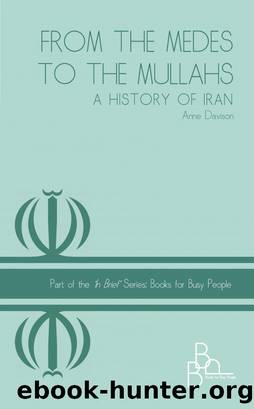From the Medes to the Mullahs a History of Iran by Anne Davison

Author:Anne Davison
Language: eng
Format: epub
Tags: iraq, iran, nuclear weapons, alexander the great, iranian revolution, shia, ancient persia, pahlavi, khomenie
Publisher: Anne Davison
The Islamic Golden Age
The Abbasid period is looked upon as a 'Golden Age' in terms of science and culture. At the same time it was increasingly recognised throughout the known world as a power to be reckoned with. The Abbasid Caliph al-Rashid, for example, established good relations in the 8th Century with Charlemagne, also known as Charles the Great, ruler of the Carolingian Dynasty and regular diplomatic missions were exchanged between the two powers.
The Abbasids ruled over territory that had previously been part of the Greek Seleucid Empire and the successive Parthian and Sassanian dynasties preserved much of the Greek culture and scholarship of the Seleucids. When the Arabs arrived in Persia in the 7th Century they therefore inherited what the Persians had preserved: Greek philosophy, astronomy, mathematics, medicine, science and literature.
This wealth of learning was eventually translated from Greek into Arabic. So began a creative coming together of Arab, Persian, Greek and Indian culture that was eventually to be carried to Western Europe via Islamic Spain and also via Constantinople to Eastern and Central Europe. From this point scholars were able to translate texts from Arabic into Latin so making ancient and valuable texts accessible to Western scholars, a process that in time contributed to the Renaissance. Similarly Biblical and Patristic texts in the Greek language found their way via Constantinople from Byzantium to the West. Consequently Western Biblical scholars had access to valuable texts in the original Greek language, a fact that influenced the unfolding of the Protestant Reformation in the 15th and 16th Centuries.
The first Abbasid Caliph, Al -Rashid, founded the 'House of Wisdom' in Baghdad and under his son al Ma'mun, who reigned from 813 to 833, this institution became the most famous in the Islamic world. Not only did it consist of a large library engaging in an ambitious translation programme, but it was also a research centre attracting scholars from across the known world. One such scholar was the Persian ibn Sina, known in the West as Avicenna. His most famous works are the Book of Healing and the Canon of Medicine, both of which were used in European universities as late as the 17th Century.
Astronomy had always been a specialism of the Persians. Traditionally, the 'Three Kings' or 'Wise Men from the Orient' who are mentioned in the Biblical nativity story are thought to have been astronomers from Persia. In the Abbasid period astronomy reached new heights.
Another great name of the period is Omar Khayyam, who was born in Nishapur, Khorasan in 1048. He is perhaps best known in the West as a poet and particularly as the author of the collection of poems known as the Rubaiyat of Omar Khayyam. Khayyam also made a significant contribution to the field of mathematics and especially algebra. He died in 1131 at the age of 82 and in 1963 the architect Hooshang Seyhoun designed a new mausoleum in his memory. Located in Nishapur, the town of the poet's birth, it is regarded today as a masterpiece of Iranian architecture.
Download
This site does not store any files on its server. We only index and link to content provided by other sites. Please contact the content providers to delete copyright contents if any and email us, we'll remove relevant links or contents immediately.
| Bahrain | Egypt |
| Iran | Iraq |
| Israel & Palestine | Jordan |
| Kuwait | Lebanon |
| Oman | Qatar |
| Saudi Arabia | Syria |
| Turkey | United Arab Emirates |
| Yemen |
Empire of the Sikhs by Patwant Singh(23025)
The Wind in My Hair by Masih Alinejad(5060)
Rise and Kill First by Ronen Bergman(4741)
The Templars by Dan Jones(4658)
The Rape of Nanking by Iris Chang(4169)
12 Strong by Doug Stanton(3528)
Blood and Sand by Alex Von Tunzelmann(3168)
Babylon's Ark by Lawrence Anthony(2650)
The History of Jihad: From Muhammad to ISIS by Spencer Robert(2601)
No Room for Small Dreams by Shimon Peres(2346)
Inside the Middle East by Avi Melamed(2331)
The Turkish Psychedelic Explosion by Daniel Spicer(2331)
Gideon's Spies: The Secret History of the Mossad by Gordon Thomas(2322)
Arabs by Eugene Rogan(2283)
The First Muslim The Story of Muhammad by Lesley Hazleton(2250)
Come, Tell Me How You Live by Mallowan Agatha Christie(2230)
Bus on Jaffa Road by Mike Kelly(2125)
Kabul 1841-42: Battle Story by Edmund Yorke(2006)
1453 by Roger Crowley(2001)
